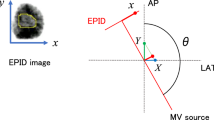Abstract
Immobilization plays an important role in intensity-modulated radiation therapy (IMRT). The application of IMRT in lung cancer patients is very difficult due to the movement of the tumor target. Patient setup in radiation treatment demands high accuracy because IMRT employs a treatment size of a 1mm pixel unit. Hence, quality assurance of the dose delivered to patients must be at its highest. The radiation dose was evaluated for breathing rates of 9, 14, and 18 breaths per minute (bpm) for tumor targets moving up and down by 1.0 cm and 1.5 cm. The dose of the moving planned target volume (PTV) was measured by using a thermo-luminescent dosimeter (TLD) and Gafchromic™ EBT film. The measurement points were 1.0 cm away from the top, the bottom and the left and the right sides of the PTV center. The evaluated dose differences ranged from 94.2 to 103.8%, from 94.4 to 105.4%, and from 90.7 to 108.5% for 9, 14 and 18 bpm, respectively, for a tumor movement of 1.0 cm. The mean values of the doses were 101.4, 99.9, and 99.5% for 9, 14 and 18 bpm, respectively, for a tumor movement of 1.0 cm. Meanwhile, the evaluated dose differences ranged from 93.6 to 105.8%, from 95.9 to 111.5%, and from 96.2 to 111.7% for 9, 14 and 18 bpm, respectively, for a tumor movement of 1.5 cm. The mean values of the doses were 102.3, 103.4, and 103.1% for 9, 14 and 18 bpm, respectively, for a tumor movement of 1.5 cm. Therefore, we suggest that IMRT can be used in the treatment of lung cancer patients with vertical target movements within the range of 1.0 to 1.5 cm.
Similar content being viewed by others
References
K. S. C. Chao, Practical essentials of Intensity Modulated Radiation Therap, 2nd ed. (Lippincott Williams and Wilkins, Philadelphia, 2005).
D. P. Gierga, G. T. Y. Chen and J. H. Kung, Int. J. Radiat. Oncol. Biol. Phys. 58(5), 1584 (2004).
K. Kitamura, H. Shirato and Y. Seppenwoolde, Int. J. Radiat. Oncol. Biol. Phys. 56(1), 221 (2003).
D. Boehmer, J. Bohsung and I. Eichwurzel, Radiother. Oncol. 71(3), 319 (2004).
J. R. Palta and T. R. Mackie, Intensity-Modulated Radiation Therapy / The State of the Art. (Medical Physics Publishing, Wisconsin, 2003).
S. Clippe, D. Sarrut and C Malet, Int. J. Radiat. Oncol. Biol. Phys. 56(1), 259 (2003).
S. A. Oh, M. K. Kang and S. K. Kim, J. Korean Phy. Soc. 60(11), 1973 (2012).
J. C. Stroom and J. M. Heijmen, Radiot. & Oncol. 64, 75 (2003).
J. Chavaudra and A. Bridier, Cancer & Radiother. 5, 472 (2001).
G. Thomas, J. Valen and H. Justin, Int. J. Radiat. Oncol. Biol. Phys. 68(4), 1030 (2007).
M. S. Rebecca, R. R. Chester and D. S. Daniel, Int. J. Radiat. Oncol. Biol. Phys. 67(2), 601 (2007).
M. A. Stltzer, C. S. Yap and D. H. Silverman, J. Nucl. Med. 43, 752 (2002).
J. Y. Chang, X. Zhang and X. Wang, J. Radiat. Oncol. Biol. Phys. 65, 1087 (2006).
M. B. Joseph, A. R. Davis and G. R. Andrew, Int. J. Radiat. Oncol. Biol. Phys. 68(4), 1229 (2007).
C. R. David, W. S. Roy and L, Zhongxing, Int. J. Radiat. Oncol. Biol. Phys. 69(2), 350 (2007).
R. Price, E. Hanks and S. W. Mcneeley, Int. J. Radiat. Oncol. Biol. Phys. 53, 236 (2002).
M. Rao, J. Wu and D. Cao, Int. J. Radiat. Oncol. Biol. Phys. 83, E251 (2012).
J. S. Shin, E. Shin and Y. Han, Radiat. Oncol. J. 29, 206 (2011).
S. K. Kim, M. S. Kim and S. M. Yun, Kor. J. Med. Phy. 17, 114 (2006).
S. B. Jiang, J. Wolfgang and G. S. Mageras, Int. J. Radiat. Oncol. Biol. Phys. 71, S103 (2008).
E. D. Ehler and W. A. Tome, Radiot. & Oncol. 88, 319 (2008).
T. Kimura, I. Nishibuchi and Y. Murakami, Int. J. Radiat. Oncol. Biol. Phys. 82, E663 (2012).
P. Keall, S. Vedam and R. George, Med. Dos. 31, 152 (2006).
J. W. Wong, M. B. Sharpe and D. A. Jaffray, Int. J. Radiat. Oncol. Biol. Phys. 44, 911 (1999).
V. M. Remouchamps, F. A. Vicini and M. B. Sharpe, Int. J. Radiat. Oncol. Biol. Phys. 55, 392 (2003).
Author information
Authors and Affiliations
Corresponding author
Rights and permissions
About this article
Cite this article
Kim, S.K., Kang, M.K., Yea, J.W. et al. Dosimetric evaluation of a moving tumor target in intensity-modulated radiation therapy (IMRT) for lung cancer patients. Journal of the Korean Physical Society 63, 67–70 (2013). https://doi.org/10.3938/jkps.63.67
Received:
Accepted:
Published:
Issue Date:
DOI: https://doi.org/10.3938/jkps.63.67




